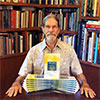What I’m Reading Now

I’ve read Volumes 1 and 4, and now I’m on Volume 2.
When I tell people what I’m reading now, the reaction is pretty universal, “I hope you don’t expect me to read that!” or something of that order. No, I don’t expect hardly anyone would enjoy what I’m finding to be fascinating—A History of Book Publishing in the United States by John Tebbel. It’s a massive four volume set and I’m a little more than halfway through with it.
Years ago, I had read Tebbel’s Between Covers: The Rise and Transformation of Book Publishing in America which is his one-volume condensation of the set, and I loved it. And then I found a super cheap copy of volume four of the entire set on eBay, and I got it thinking that I’d just read the chapter on the 1970’s since I opened my first bookstore in 1971. Well, that chapter was so good that I went to page one and read the whole volume. Then I got this bug that maybe I wanted to read the whole set so I checked the Hawaii State Library System, and indeed they have the set, but you can’t check it out (and I bet nobody reads it, consequently). So I checked the internet, and found that the set could be gotten quite cheaply. (I guess there’s not much demand.) So I got the whole set, and since I then had two copies of volume four, I gave one to my publisher George Engebretson, and last I saw it’s in his office looking nicely official.

These are the three books I’m reading in tandem. Together they give a fuller picture of the times.
It took me many months to get through volume one and now I’m about 30 pages into volume two. I only read a few pages at night—just before I go to sleep. Oh, I guess you could say it puts me to sleep, but that’s not really accurate. I’ve decided to do something I’ve never done before—read three books in tandem. The other two books are: The Popular Book: A History of America’s Literary Taste by James D. Hart and Golden Multitudes” The Story of Best Sellers in the United States by Frank Luther Mott. The former book is one I read in the 1980’s so it seems new to me now, and the latter book is one I found out about by reading Tebbel’s references. I’m finding that reading all three together is very enriching, since each book has a different take on the subject.
Back to Tebbel’s big four volume set—since I’m from Alabama, one of the things I found most interesting was that the South, before the Civil War, repressed both reading and publishing. The white landowners figured (accurately) that, if people were educated, they wouldn’t favor slavery. “In Tennessee, Webster’s dictionary was virtually boycotted because it defined a slave as ‘a person subject to the will of another, a drudge.’” Tebbel goes on to say, “…publishing in the South was bound in chains as strong a slavery itself…” So when you hear about ignorant Southerners—well, it was planned that way!
Leave a Comment Cancel Comment
Related Posts
Books About Books—My Favorite Subject
I’m in a Recently Published Book
Feng Shui & Real Books (Part 1)
Recent Posts
Three Famous Gay Men from Huntsville, Alabama

My Youtube Feng Shui Channel




Article Comments